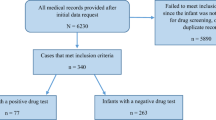Abstract
Objective:
To evaluate the impact of Early Start, an obstetric clinic-based prenatal substance abuse treatment program, on perinatal outcomes.
Study Design:
Subjects were 49 985 women who completed Prenatal Substance Abuse Screening Questionnaires at obstetric clinics between 1 January 1999 and 30 June 2003, had urine toxicology screening tests and either live births or intrauterine fetal demises (IUFDs). Four groups were compared: women screened/assessed positive and treated by Early Start (‘SAT’, n=2073); women screened/assessed positive without treatment (‘SA’, n=1203); women screened positive only (‘S’, n=156); controls who screened negative (n=46 553). Ten neonatal and maternal outcomes were studied.
Result:
SAT women had either similar or slightly higher rates than the control women on most outcomes but significantly lower rates than S women. SA women generally had intermediate rates to the SAT and S groups. In multivariate analysis, the S group had significantly worse outcomes than the SAT group: preterm delivery (odds ratio (OR)=2.1, 1.3 to 3.2), placental abruption (OR=6.8, 3.0 to 15.5) and IUFD (OR=16.2, 6.0 to 43.8).
Conclusion:
Substance abuse treatment integrated with prenatal visits was associated with a positive effect on maternal and newborn health.
This is a preview of subscription content, access via your institution
Access options
Subscribe to this journal
Receive 12 print issues and online access
$259.00 per year
only $21.58 per issue
Buy this article
- Purchase on Springer Link
- Instant access to full article PDF
Prices may be subject to local taxes which are calculated during checkout
Similar content being viewed by others
References
Bauer CR . Perinatal effects of prenatal drug exposure. Neonatal aspects. Clin Perinatol 1999; 26 (1): 87–106.
Dattel BJ, Kandall SR . Substance abuse in pregnancy. Semin Perinatol 1990; 14 (2): 179–187.
Finnegan LP . Maternal and neonatal effects of alcohol and drugs. In: Lowinson JH, Ruiz P, Millman RB, Langrod JG (eds). Substance Abuse: a Comprehensive Textbook. Williams and Wilkins: Baltimore, MD, 1997, pp 513–532.
Johnson K, Greenough A, Gerada C . Maternal drug use and length of neonatal unit stay. Addiction 2003; 98 (6): 785–789.
Paine LL, Garceau LM . Health behaviors during pregnancy: risks and interventions. In: McCormick MC, Siegel JE (eds). Prenatal Care. Effectiveness and Implementation. Cambridge University Press: New York, NY, 1999, pp 33–62.
Shiono PH . Prevalence of drug-exposed infants. Future Child 1996; 6 (2): 159–163.
Smeriglio VL, Wilcox HC . Prenatal drug exposure and child outcome. Past, present, future. Clin Perinatol 1999; 26 (1): 1–16.
U.S. Department of Health and Human Services, Substance Abuse and Mental Health Services Administration. The National Survey on Drug Use and Health Report. Substance Use During Pregnancy: 2002 and 2003 Update 2005; Office of Applied Studies: Rockville, MD, 1–3.
Office of Disease Prevention and Health Promotion. Healthy People 2010: Vol. II. Objectives for Improving Health (Part B). Department of Health and Human Services, Rockville, MD, 2001.
American College of Obstetricians and Gynecologists Committee on Ethics. At-Risk Drinking and Illicit Drug Use: Ethical Issues in Obstetric and Gynecological Practice. Committee Opinion no. 294. ACOG: Washington DC, 2004 pp 1–11.
American Psychiatric Association 2000. (DSM-IV-TR) Diagnostic and Statistical Manual of Mental Disorders, 4th edn, text revision American Psychiatric Press Inc: Washington, DC, 2000.
Armstrong MA, Lieberman L, Carpenter DM, Gonzales VM, Usatin MS, Newman L et al. Early Start: an obstetric clinic-based, perinatal substance abuse intervention program. Qual Manag Health Care Winter 2001; 9 (2): 6–15.
Armstrong MA, Gonzales Osejo V, Lieberman L, Carpenter DM, Pantoja PM, Escobar GJ . Perinatal substance abuse intervention in obstetric clinics decreases adverse neonatal outcomes. J Perinatol 2003; 23 (1): 3–9.
Escobar GJ, Li DK, Armstrong MA, Gardner MN, Folck BF, Verdi JE et al. Neonatal sepsis workups in infants ⩾2000 grams at birth: a population-based study. Pediatrics 2000; 106 (2 Part 1): 256–263.
Selby JV . Linking automated databases for research in managed care settings. Ann Int Med 1997; 127 (8 part 2): 719–724.
Escobar GJ, Fischer A, Kremers R, Usatin MS, Macedo AM, Gardner MN . Rapid retrieval of neonatal outcomes data: the Kaiser Permanente Neonatal Minimum Data Set. Qual Manag Health Care Summer 1997; 5 (4): 19–33.
Escobar GJ . The neonatal ‘sepsis work-up’: personal reflections on the development of an evidence-based approach toward newborn infections in a managed care organization. Pediatrics 1999; 103 (1 Supplement E): 360–373.
Ananth CV, Oyelese Y, Yeo L, Pradhan A, Vintzileos AM . Placental abruption in the United States, 1979 through 2001: temporal trends and potential determinants. Am J Obstet Gynecol 2005; 192 (1): 191–198.
MacDorman MF, Hoyert DL, Martin JA, Munson ML, Hamilton BE . Fetal and perinatal mortality, United States, 2003. Hyattsville MD. National Vital Statistics Reports. National Center for Health Statistics 2007; 55 (6): 1–18.
Acknowledgements
This project was supported by a grant from the Direct Community Benefit Investment Fund of the Kaiser Foundation Research Institute, Oakland, CA.
Author information
Authors and Affiliations
Corresponding author
Rights and permissions
About this article
Cite this article
Goler, N., Armstrong, M., Taillac, C. et al. Substance abuse treatment linked with prenatal visits improves perinatal outcomes: a new standard. J Perinatol 28, 597–603 (2008). https://doi.org/10.1038/jp.2008.70
Received:
Revised:
Accepted:
Published:
Issue Date:
DOI: https://doi.org/10.1038/jp.2008.70
Keywords
This article is cited by
-
Drug policies’ sensitivity towards women, pregnancy, and motherhood: a content analysis of national policy and programs from nine countries and their adherence to international guidelines
Addiction Science & Clinical Practice (2023)
-
Lessons Learned Serving Pregnant, Postpartum, and Parenting People with Substance Use Disorders in Massachusetts: The Moms Do Care Program
Maternal and Child Health Journal (2023)
-
Stressful life events and prescription opioid use during pregnancy: findings from the 2019 pregnancy risk assessment monitoring system
Social Psychiatry and Psychiatric Epidemiology (2022)
-
Maternal Complications and Prescription Opioid Exposure During Pregnancy: Using Marginal Structural Models
Drug Safety (2021)
-
Correlates of Pregnant Women’s Participation in a Substance Use Assessment and Counseling Intervention Integrated into Prenatal Care
Maternal and Child Health Journal (2020)


